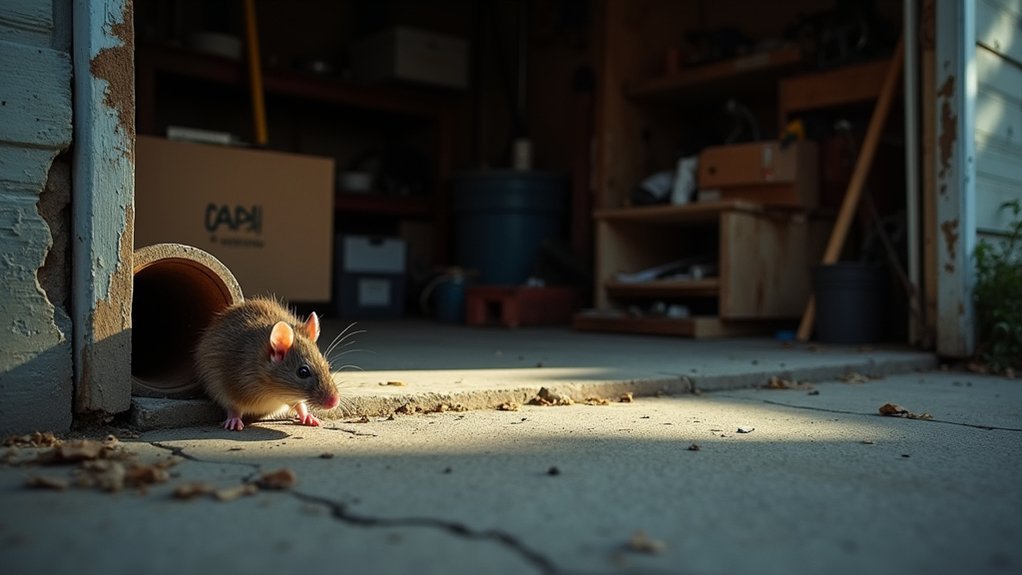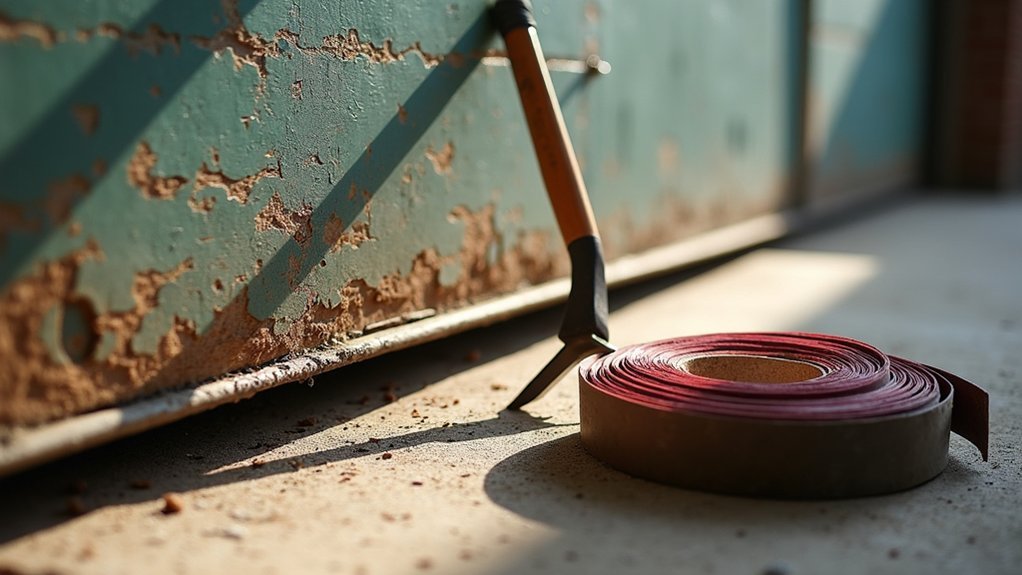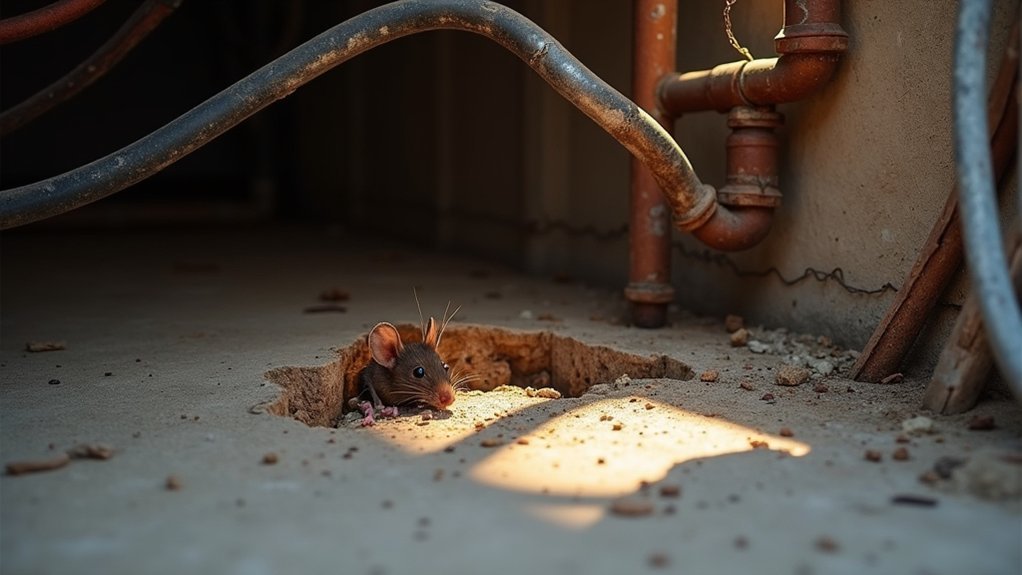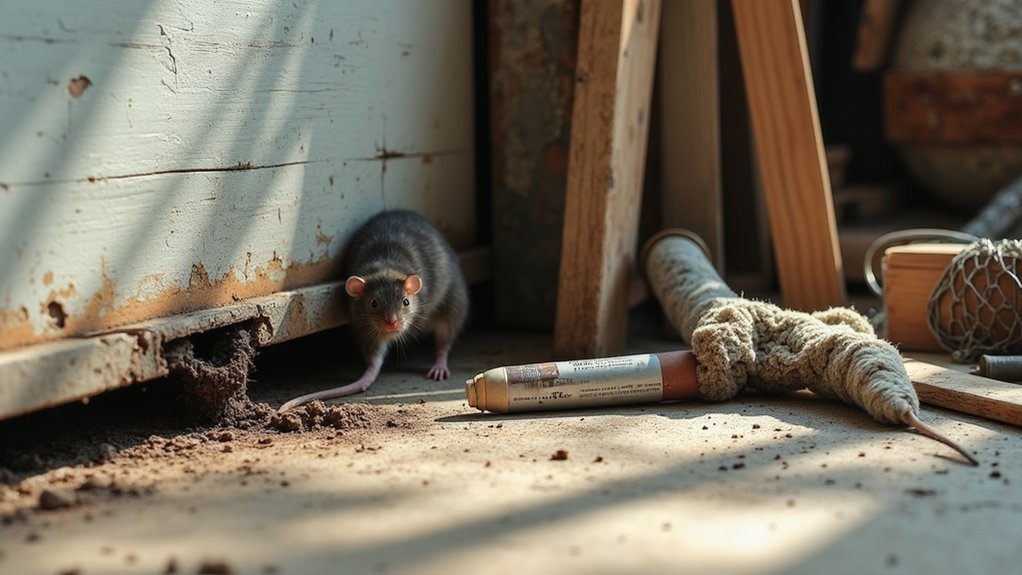Rats invade garages seeking shelter, food, and nesting sites, entering through holes as small as 1/2 inch. You’ll need to seal foundation cracks, gaps under doors, and openings around pipes with caulk and copper mesh. Install door sweeps, weather stripping, and vent covers to block entry points. Place snap traps along walls and near signs of activity, using peanut butter as bait. Proper exclusion techniques and regular maintenance create the rodent-proof environment you’ve been searching for.
Common Entry Points for Rats in Garage Structures

While you might think your garage is secure, rats are remarkably resourceful intruders that can exploit even the tiniest vulnerabilities in your structure. They can squeeze through openings as small as 1/2 inch, making it essential to inspect for gaps around doors, windows, and wall junctions.
Foundation cracks and deteriorating walls serve as prime entry points for rodent infestations. Pay special attention to unsealed vents and roof openings, which provide direct access if not properly protected.
Your garage’s proximity to dense vegetation creates natural pathways for rats to approach your building undetected.
Perhaps the most overlooked vulnerability is simply leaving your garage door open, especially at night when rats are most active. This effectively rolls out the welcome mat for these unwanted guests.
Essential Supplies for DIY Garage Rodent Exclusion
Before commencing your rat-proofing mission, you’ll need to gather specific supplies designed to outsmart these persistent invaders.
Start with quality caulk to seal small gaps around windows and foundation points of entry. Copper mesh is essential for larger holes, as rats can’t chew through it, creating a durable barrier against infestations.
Don’t forget to purchase door sweeps or thresholds to eliminate the gap beneath your garage door where rodents commonly enter.
Keep snap traps readily available for immediate deployment when you notice signs of rodent activity. A good flashlight is indispensable for thorough inspections of dark corners and behind stored items.
While these DIY solutions are effective, remember that persistent infestations may require professional pest control services to completely secure your garage.
Sealing Garage Door Gaps and Weather Stripping

You’ll need quality weatherstripping and door seals to defend against rats entering through garage door gaps.
Install a durable bottom threshold made of rubber or vinyl that creates a tight seal against your garage floor when closed.
Properly securing weatherstripping along the sides and top of your garage door eliminates the small crevices that rats exploit to gain entry to your home.
Door Sealing Materials
Gaps in garage doors create an open invitation for rats to enter your home, with even the smallest openings serving as potential entryways.
Remember that rats can squeeze through holes barely larger than a dime, making proper door sealing materials essential for effective rodent exclusion.
Weather stripping is your primary defense, creating a barrier that blocks both drafts and rodents simultaneously. Install it along the sides and top of your garage door for maximum protection.
For the bottom edge, add a door sweep to seal against rodents attempting to enter from ground level.
For areas particularly vulnerable to gnawing, reinforce your defenses with copper mesh or steel wool before applying caulk. These materials resist rodent teeth and create a more durable seal.
Regularly inspect and replace damaged weather stripping to maintain your garage’s rodent-proof integrity.
Bottom Garage Thresholds
Along the bottom edge of your garage door lurks one of the most vulnerable entry points for rats in your home. These rodents can squeeze through gaps as small as 1/4 inch, making bottom garage thresholds critical areas to protect.
To effectively seal these areas, install weather stripping made of durable materials like rubber or heavy-duty vinyl. This creates a tight barrier that reduces air leaks while blocking rats from entering.
Add a door sweep for extra protection, closing off the space where the door meets the ground.
Don’t forget to inspect your garage door regularly for signs of wear. Weather stripping deteriorates over time, creating new entry points for rats.
Weatherstrip Proper Installation
Properly installed weather stripping forms the backbone of any effective rat exclusion strategy for your garage. Choose durable, flexible materials like rubber or vinyl that withstand temperature changes while maintaining a tight seal against rodent invaders.
For thorough rodent control, install weather stripping along the bottom edge and vertical sides of your garage door, sealing any gaps larger than 1/4 inch. Pair this with a door sweep at the threshold for maximum protection. These entry points are often the first signs of an infestation when damaged.
Inspect your weather stripping regularly for wear, compression, or damage. When you notice deterioration, replace it immediately—rats need only a small opening to enter.
Protecting Vulnerable Areas: Vents, Pipes, and Cables

You’ll need to examine all vents, pipes, and cable entry points in your garage as rats can squeeze through gaps as small as a quarter inch.
Install vent covers or screens on any openings while wrapping exposed pipes and cables with copper mesh, which rats can’t chew through.
Remember to seal gaps where utilities enter your garage with caulk or steel wool, eliminating these common but often overlooked rodent highways.
Missing Vent Covers
Vulnerable ventilation systems present one of the most common entryways for rats seeking shelter in your garage. Missing vent covers fundamentally roll out the welcome mat for these unwanted guests.
To achieve effective rodent exclusion, you’ll need to identify and seal gaps throughout your ventilation network.
- Install durable vent covers made of metal or strong plastic that rats can’t easily chew through
- Use copper mesh or steel wool to reinforce areas around pipes and cables where rodents might attempt entry
- Conduct monthly inspections of all vents to verify covers remain intact and properly sealed
When you properly protect these access points, you’ll prevent infestations before they start.
Remember that rats can squeeze through remarkably small openings, so even minor gaps require attention during your DIY exclusion efforts.
Utility Pipe Gaps
Rats frequently exploit utility pipe gaps as convenient highways into your garage, where unprotected openings provide an irresistible invitation. These rodents can squeeze through holes as small as a dime, making it essential to seal gaps around all utility pipes and cable entry points.
| Location | Deterrent Materials | Effectiveness | Maintenance |
|---|---|---|---|
| Cable entries | Copper mesh | High | Check quarterly |
| Water pipes | Steel wool | Very high | Inspect after rains |
| Gas lines | Metal flashing | High | Annual inspection |
| Electrical conduits | Expanding foam + steel wool | Medium-high | Check if disturbed |
Inspect these vulnerable areas regularly for wear and damage. When sealing utility pipes, confirm you’re using materials rats can’t chew through. This protective approach not only blocks unwanted visitors but also improves energy efficiency and reduces health risks associated with rodent infestations.
Cable Entry Points
Three primary cable entry points in your garage serve as common rat highways: electrical wiring conduits, internet/cable TV lines, and security system wiring.
Rats can squeeze through openings as small as a dime, making unsealed cable penetrations ideal entry points into your garage.
To prevent rats from exploiting these vulnerabilities:
- Inspect all perimeter cable entry points monthly, focusing on areas where utilities enter your garage walls and foundation.
- Use copper mesh to seal larger gaps around cables—it’s durable and resistant to rodent gnawing.
- Install proper cable pass-through plates with rubber gaskets that maintain a tight seal while allowing cable movement.
Remember to check these areas after any utility work, as technicians might leave gaps unsealed.
Maintaining proper seals around all cable penetrations eliminates these convenient access routes that rats readily exploit.
Effective Placement of Traps and Monitoring Stations
Strategic placement of traps and monitoring stations is essential for successful rat control in your home. To establish an effective rodent defense, place traps along walls and near signs of activity like droppings or gnaw marks. Set multiple traps in each problem area to increase capture rates.
| Location | Trap Type | Bait Suggestion | Checking Frequency |
|---|---|---|---|
| Corners | Snap traps | Peanut butter | Every 2-3 days |
| Entry points | Glue boards | Dried fruit | Daily |
| Behind appliances | Live traps | Seeds/nuts | Every 2 days |
| Near food sources | Bait stations | Commercial bait | Twice weekly |
Remember to secure bait firmly to prevent theft without triggering the trap. Position your monitoring stations strategically near potential hiding spots, checking them regularly to assess activity levels and the effectiveness of your control methods.
Maintaining a Rodent-Proof Garage Year-Round
While seasonal changes invite different challenges, your garage requires year-round vigilance to remain rodent-free.
Maintaining a rodent-free garage demands consistent attention regardless of the season or weather conditions.
Regularly inspect your garage’s perimeter for cracks and gaps, sealing any openings immediately—rats can squeeze through holes as small as a quarter. Store all food items and pet supplies in airtight containers to eliminate attractants that draw rodents to your space.
Monitor for signs of rodent activity by checking corners and sheltered areas for droppings, gnaw marks, or nesting materials. Early detection prevents small problems from becoming full-blown infestations.
- Create a quarterly maintenance schedule to check weather stripping and door sweeps
- Apply natural deterrents like peppermint oil along entry points during peak rodent seasons
- Remove clutter monthly to eliminate potential nesting sites and improve visibility for inspections
Frequently Asked Questions
How to Repel Rats From the Garage?
To repel rats from your garage, seal all entry points with caulk and copper mesh, keep it clean and clutter-free, store food in airtight containers, use peppermint oil repellents, and make certain doors close tightly.
What Do Rats Hate Most?
Rats hate peppermint oil most intensely, followed by ammonia and vinegar. They’re also repelled by ultrasonic sounds. You’ll find they avoid clean, clutter-free spaces where they can’t hide or find food.
What Materials Are Used for Rat Exclusion?
For rat exclusion, you’ll need copper mesh for large gaps, expanding foam sealant for cracks, caulk for small holes, steel wool as a barrier, and weather stripping with door sweeps to seal entryways completely.
Why Do Rats Keep Coming Into My Garage?
Rats keep entering your garage because they’re finding food sources, shelter, and easy access points. You’re likely overlooking unsealed gaps, available food, or nearby clutter that’s attracting them to your space.
In Summary
Taking proactive steps to exclude rats from your garage isn’t just about comfort—it’s about protecting your property and health. By identifying entry points, sealing gaps, and maintaining vigilance, you’ve created an environment that’s far less appealing to rodents. Remember, consistency is key; check your exclusion methods regularly and address new vulnerabilities promptly. With these DIY solutions, you’ll keep your garage rodent-free for years to come.





Leave a Reply